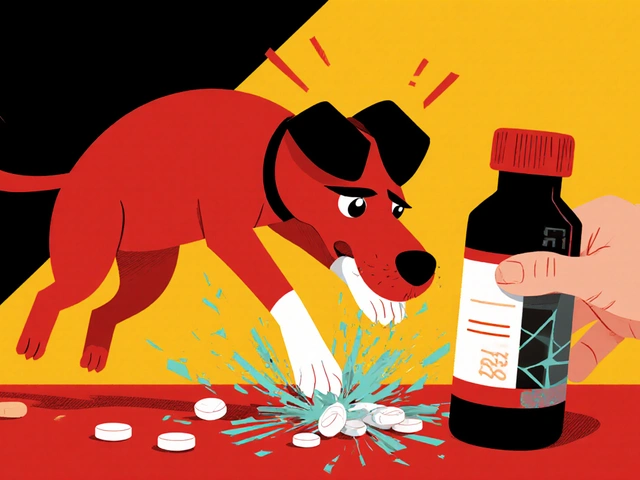Stopping timolol suddenly can be dangerous. If you’ve been taking it for glaucoma or high blood pressure, your body has adapted to its presence. Shutting it off fast can cause your heart rate to spike, your blood pressure to rebound, or even trigger a heart attack or worsening glaucoma. That’s why you never quit timolol on your own. This guide walks you through exactly how to stop it safely - step by step - based on real clinical protocols and patient experiences.
Why Timolol Can’t Be Stopped Cold Turkey
Timolol is a beta blocker. It works by blocking adrenaline effects on your heart and eyes. For glaucoma, it reduces fluid production inside the eye. For high blood pressure, it slows your heart and relaxes blood vessels. When you take it regularly, your body adjusts. Your heart gets used to a lower workload. Your eye’s fluid drainage system becomes dependent on the drug’s suppression.
Stop it abruptly, and your body goes into overdrive. Adrenaline floods back in. Your heart races. Blood pressure spikes. In glaucoma patients, intraocular pressure can jump 10-20 mmHg within days. A 2023 study in the Journal of Glaucoma found that 17% of patients who quit timolol without tapering had measurable vision loss within two weeks. That’s not rare. It’s predictable.
You’re not weak for needing help stopping. You’re smart for asking.
Step 1: Talk to Your Doctor Before You Do Anything
Never adjust your timolol dose without medical supervision. Even if you feel fine, or think you don’t need it anymore, your doctor is the only one who can decide if and how to stop it. They’ll check your latest eye pressure readings, heart function, and any new health changes - like pregnancy, asthma, or heart failure - that might change your plan.
Bring a list of everything you’re taking. Some medications - like other eye drops, antidepressants, or calcium channel blockers - can interact with timolol withdrawal. Your doctor needs the full picture.
Step 2: Get a Tapering Schedule
There’s no one-size-fits-all taper. It depends on how long you’ve taken timolol, your dose, your condition, and your overall health. But here’s what most doctors follow:
- For glaucoma patients on 0.5% timolol once daily: Switch to every other day for 1-2 weeks, then reduce to every third day for another week, then stop.
- For patients on 0.5% twice daily: Drop to once daily for 2 weeks, then every other day for 1-2 weeks, then stop.
- For those on higher doses or with heart conditions: Tapers may take 4-8 weeks. Some doctors switch to a different beta blocker first (like metoprolol) before fully stopping.
Your doctor might use a “half-dose” strategy - splitting the drop to deliver half the volume - if they don’t have a lower-strength formulation. This isn’t ideal, but it’s sometimes necessary. Ask if a compounded version is available.
Step 3: Monitor Your Body Closely
While tapering, keep track of these signs:
- Eye pressure: If you have a home tonometer, check daily. If not, schedule pressure checks every 7-10 days.
- Heart rate: If you feel your pulse racing (over 100 bpm at rest), dizziness, or chest tightness, pause the taper and call your doctor.
- Blood pressure: Use a home monitor if you have one. A sudden rise above 160/100 mmHg is a red flag.
- Vision changes: Blurry vision, halos, or blind spots? Don’t wait. Get checked immediately.
Keep a simple log: date, dose, symptoms, eye pressure, heart rate. Bring it to every appointment. This isn’t extra work - it’s your safety net.

Step 4: Watch for Rebound Effects
Rebound hypertension and increased intraocular pressure are the biggest risks. They often show up 3-7 days after your last dose. Even if you’ve tapered slowly, don’t assume you’re safe just because you stopped.
Signs of rebound:
- Headaches, especially in the morning
- Blurred vision or seeing rainbow halos around lights
- Palpitations or shortness of breath with light activity
- Unexplained anxiety or sweating
If you notice any of these, contact your doctor right away. You may need to temporarily restart a lower dose or switch to another medication.
Step 5: Replace Timolol with Safer Alternatives (If Needed)
Stopping timolol doesn’t mean stopping treatment. For glaucoma, alternatives include:
- Prostaglandin analogs: Latanoprost, bimatoprost - often more effective and once-daily.
- Alpha agonists: Brimonidine - can be used alone or with other drops.
- Carbonic anhydrase inhibitors: Dorzolamide - works differently than beta blockers.
For blood pressure, alternatives include:
- ACE inhibitors: Lisinopril
- Calcium channel blockers: Amlodipine
- Diuretics: Hydrochlorothiazide
Your doctor will pick the best replacement based on your age, other conditions, and side effect risks. Don’t assume one is “better” - it’s about what fits your body.
Step 6: Schedule Follow-Up Appointments
Don’t disappear after your last drop. Schedule:
- A follow-up eye exam within 2 weeks of stopping
- A blood pressure check within 1 week (or sooner if symptoms appear)
- A full cardiac evaluation if you have a history of heart disease
Some patients think they’re fine because they don’t feel symptoms. But glaucoma damage is silent. High blood pressure spikes can happen without warning. These appointments aren’t optional. They’re your last line of defense.

What If You Accidentally Missed a Dose?
If you forget a dose during tapering, don’t double up. Just take your next dose at the regular time. If you miss multiple doses in a row, contact your doctor. You may need to pause the taper and reset.
If you stop completely by accident - maybe you ran out and didn’t refill - don’t panic. But don’t wait. Call your doctor the same day. They may advise you to restart the lowest dose temporarily until you can schedule a proper taper.
Common Mistakes People Make
Here’s what goes wrong when people try to quit timolol on their own:
- Assuming it’s “just an eye drop”: Timolol is absorbed into your bloodstream. It affects your heart, lungs, and brain.
- Stopping because of side effects: Dry eyes or fatigue? Talk to your doctor. There are solutions - switching brands, changing timing, or adding lubricating drops.
- Using OTC alternatives: “Natural” eye drops or supplements won’t replace timolol. They don’t lower eye pressure reliably.
- Waiting too long to get help: Delaying care after stopping can lead to permanent damage.
Timolol isn’t addictive. But your body relies on it. Treating it like a habit you can quit cold turkey is dangerous.
When to Seek Emergency Help
Call 911 or go to the ER if you experience:
- Chest pain or pressure
- Severe headache with blurred vision
- Sudden loss of vision in one or both eyes
- Heart rate over 120 bpm at rest with dizziness
- Difficulty breathing or fainting
These aren’t “maybe” situations. They’re emergencies. Don’t wait to see if it gets better.
Final Thoughts
Stopping timolol isn’t about willpower. It’s about science. It’s about your body’s chemistry. It’s about protecting your vision and your heart. The steps here aren’t suggestions - they’re proven safety measures backed by years of clinical data.
If you’re thinking about quitting, you’re already doing the right thing by looking for answers. Now, take the next step: call your doctor. Don’t wait. Don’t guess. Get your personalized plan today.
Can I stop timolol if I feel fine?
No. Feeling fine doesn’t mean it’s safe. Timolol works behind the scenes to control eye pressure and heart function. Stopping suddenly can cause dangerous rebounds even if you have no symptoms. Always follow a doctor-approved taper.
How long does it take to safely stop timolol?
It usually takes 2 to 8 weeks, depending on your dose and health. For glaucoma, most people taper over 3-4 weeks. For heart conditions, it may take longer. Your doctor will create a timeline based on your specific needs.
What happens if I stop timolol too fast?
Stopping too fast can cause rebound high blood pressure, rapid heart rate, chest pain, or a sudden spike in eye pressure that damages your optic nerve. In severe cases, it can lead to heart attack or permanent vision loss. Never skip the taper.
Are there natural ways to replace timolol for glaucoma?
No. There are no proven natural alternatives that reliably lower intraocular pressure like timolol. Supplements like bilberry or omega-3s may support eye health, but they don’t replace medication. Relying on them instead of a doctor’s plan puts your vision at risk.
Can I switch to a different eye drop instead of stopping?
Yes. Many patients switch to prostaglandin analogs like latanoprost, which are often more effective and have fewer systemic side effects. Your doctor can help you transition smoothly without stopping treatment entirely.
Will my eye pressure go back up after stopping timolol?
It often does - that’s why tapering and follow-up are critical. But if you switch to another effective medication, your pressure can stay controlled. The goal isn’t to stop treatment - it’s to stop timolol safely and replace it with something better suited to you.





It's wild how we treat eye drops like they're harmless candy. Timolol doesn't just sit in your eye-it rewires your whole nervous system. I used to think if I felt fine, I could just quit. Turns out my body was screaming silently. Now I see medicine isn't about feeling good-it's about keeping the machinery running even when you don't notice it.
November 20Brad Samuels